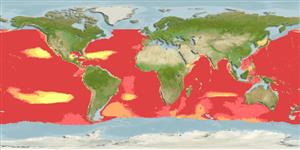>
Myctophiformes (Lanternfishes) >
Myctophidae (Lanternfishes) > Gymnoscopelinae
Etymology: Notoscopelus: Greek, noton = back + Greek, skopelos = a lantern fish (Ref. 45335); resplendens: From the Latin 'resplendere' which means to shine brightly (Ref. 6885).
More on author: Richardson.
Environment: milieu / climate zone / depth range / distribution range
Ecología
marino batipelágico; oceanodromo (Ref. 51243); rango de profundidad 777 - 2121 m (Ref. 44036). Deep-water; 55°N - 61°S
Atlantic Ocean: about 35°N (east of 40°W) and 47°N (west of 40°W) to the southern Subtropical Convergence at 40°S, but with discontinuity in the region of the cyclonic gyre 2°S - 11°S, in the eastern Atlantic and in the minimum region off Brazil (5°-9°S to 21°S). Indian Ocean: between 24° and 30°S. Western Pacific: northwest Pacific to off Australia and New Zealand (absent from western tropical Pacific and southeast Asian seas, Ref. 5182). Eastern Pacific: south of 55°N (Ref. 265) to 34°S, west of 80°W but to 20°S in Peruvian Transitional Zone. Southern Ocean: at 60°58'S, 48°05'W (Ref. 5182). South China Sea (Ref.74511).
Length at first maturity / Tamaño / Peso / Age
Maturity: Lm ?, range 4 - ? cm
Max length : 9.5 cm SL macho / no sexado; (Ref. 4479); peso máximo publicado: 9.90 g (Ref. 126117)
Short description
Claves de identificación | Morfología | Morfometría
Espinas dorsales (total) : 0; Radios blandos dorsales (total) : 21 - 24; Espinas anales: 0; Radios blandos anales: 18 - 20; Vértebra: 35 - 38. Branchiostegal rays: 9-10 (Ref. 31442). Anal organs 13; can be easily distinguished from other species of the genus by its gill raker count (Ref. 39633).
High-oceanic, epipelagic to mesopelagic (Ref. 31442). Bathypelagic (Ref. 58302). Nyctoepipelagic at the surface and down to 300 m and found between 651-2,000 m during the day (Ref. 4479). Oviparous, with planktonic eggs and larvae (Ref. 31442).
Life cycle and mating behavior
Madurez | Reproducción | Puesta | Huevos | Fecundidad | Larva
Hulley, P.A., 1990. Myctophidae. p. 398-467. In J.C. Quero, J.C. Hureau, C. Karrer, A. Post and L. Saldanha (eds.) Check-list of the fishes of the eastern tropical Atlantic (CLOFETA). JNICT, Lisbon; SEI; Paris; and UNESCO, Paris. Vol. 1. (Ref. 4479)
IUCN Red List Status (Ref. 130435: Version 2024-1)
Threat to humans
Harmless
Human uses
Herramientas
Special reports
Download XML
Fuentes de Internet
Estimates based on models
Preferred temperature (Ref.
123201): 2.4 - 6.9, mean 4.1 °C (based on 1475 cells).
Phylogenetic diversity index (Ref.
82804): PD
50 = 0.5156 [Uniqueness, from 0.5 = low to 2.0 = high].
Bayesian length-weight: a=0.00589 (0.00323 - 0.01073), b=3.18 (3.01 - 3.35), in cm total length, based on LWR estimates for this species & (Sub)family-body (Ref.
93245).
Nivel trófico (Ref.
69278): 3.0 ±0.00 se; based on food items.
Resiliencia (Ref.
120179): Alto, población duplicada en un tiempo mínimo inferior a 15 meses (Preliminary K or Fecundity.).
Fishing Vulnerability (Ref.
59153): Low vulnerability (10 of 100).
Nutrients (Ref.
124155): Calcium = 95.4 [25.1, 258.5] mg/100g; Iron = 0.528 [0.190, 1.695] mg/100g; Protein = 16.3 [14.5, 18.1] %; Omega3 = 0.331 [0.109, 0.968] g/100g; Selenium = 14.8 [4.2, 47.5] μg/100g; VitaminA = 91.8 [10.8, 815.0] μg/100g; Zinc = 0.875 [0.437, 1.909] mg/100g (wet weight);
